Nvidia GeForce GTX Titan First Look
February 19, 2013 | 13:57
Companies: #nvidia-geforce-gtx-titan-first-look #titan

Nvidia GeForce GTX Titan First Look
Manufacturer: NvidiaUK Price (as reviewed): MSRP £827 (inc. VAT)
US Price (as reviewed): MSRP $1000 (ex. Tax)
It’s been a while since we’ve seen a new GPU and with AMD’s news last week that it doesn’t plan to release its new Sea Islands architecture any time soon, we were resigned to a long wait for that next-gen console crusher.
We were more than surprised then, when Nvidia popped up with today’s announcement; the launch of GeForce GTX Titan. Rather than push the GTX 680 2GB down a rung or reshuffle it’s wide array of SKUs, the GTX Titan occupies an entirely new rung on Nvidia’s ladder; a super-premium single GPU card that's likely to top Nvidia's range for some time to come. With a price rumoured to be around the £830 mark though, just how can Nvidia justify that kind of financial outlay on a single-GPU card?
Sadly we’re under NDA until 2pm of Thursday this week when it comes to performance numbers or analysis, but on all other fronts the wraps are off, so let’s dig in and find out what’s new with GTX Titan.
Click to enlarge - Token arty shot
GK110 Finally comes to the desktop
As we’ve spoken about in the past, the GK104 Kepler architecture employed in the GeForce 6-series to date has been an updated version of Nvidia’s GF114 chips, previously found in the well-received GTX 560 Ti 2GB. Meanwhile the GK110 GPU (the 28nm version of the GF110 used in the GTX 580) has been instead used for far dearer Telsa compute cards. It’s the largest accumulation of these Tesla cards, the 18,688 Tesla K20 equipped Titan super computer at the Oak Ridge National Laboratory, where the GTX Titan takes its name.
The GPU at Titan’s heart isn’t quite the same as that found in the £2,500 Tesla K20, but it’s not far off and certainly as close as we’re going get to a full fat Kepler GPU this generation. The humongous 551mm² 7.1 billion transistor GPU still uses the same SMX/GPC design as the existing GTX 6-series, but with a far larger overall number of stream processors, texture units and memory controllers.
Click to enlarge - GK110 finally comes to the desktop
Each SMX still contains the same 192 stream processors though, along with an accompanying 16 texture units, but now also includes 64 double precision units (DP Units) for enhanced compute functionality. This was missing from the rest of the GTX 6-series, despite being available in AMD’s 7-series as far down as its HD 7770, so its inclusion here highlight’s Nvidia’s hope that this card may attract compute customers priced out by its Tesla cards.
Other than the addition of the DP units though, the SMX architecture is unchanged, with the same four warp schedulers and eight dispatch units. The block diagram below is taken from Nvidia’s original GK110 white paper, but there’s also Nvidia’s polymorph engine attached to each SMX, each including its own tessellation unit.
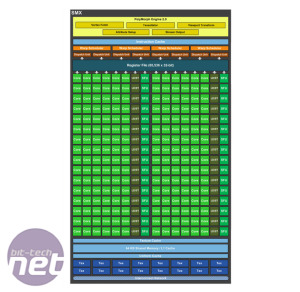
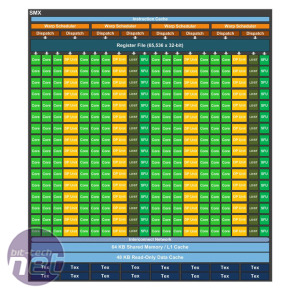
Click to enlarge - the SMX design of the Gk104 (left) and GK110 (right) GPUS is fundamentally unchanged beyond the addition of Double Precision units
Where things change however is in the step up to the GPC (graphics processor cluster). Whereas GK104’s layout allowed for 2 SMX per GPC, GK110 allows for up to three SMX per GPC. However, the GK110 chip in the GTX Titan isn’t fully complimented; while the GK110 in its Tesla K20 cards sports 2,880 stream processors split across five GPCs of three SMXs each, Titan’s fifth GPC sports just a pair of SMX, for a total of 2,688 stream processors. In comparison to the GTX 680 2GB’s 1,526 stream processors this is still a huge step however, with the GTX Titan boasting 75 per cent more stream processors than its £380 stable-mate.
GeForce GTX Titan Specs
| Nvidia GeForce GTX Titan 6GB | Nvidia GeForce GTX 690 4GB | Nvidia GeForce GTX 680 2GB | Nvidia GeForce GTX 670 2GB | Nvidia GeForce GTX 660 Ti 2GB | |
| GPU | |||||
| Codename | GK110 | 2 x GK104 | GK104 | GK104 | GK104 |
| Base Clock | 836MHz | 915MHz | 1,006MHz | 915MHz | 915MHz |
| Boost Clock | 876MHz | 1,019MHz | 1,058MHz | 980MHz | 980MHz |
| Stream Processors | 2,688 | 2 x 1,536 | 1536 | 1344 | 1344 |
| Layout | 14 SMs, 5 GPCs | 2 x 8 SMs, 4 GPCs | 8 SMs, 4 GPCs | 7 SMs, 4 GPCs | 7 SMs, 4 GPCs |
| Rasterisers | 5 | 2 x 4 | 4 | 4 | 4 |
| Tesselation Units | 14 | 2 x 8 | 8 | 7 | 7 |
| Texture Units | 224 | 2 x 128 | 128 | 112 | 112 |
| ROPs | 48 | 2 x 32 | 32 | 32 | 24 |
| Transistors | 7.1 Billion | 2 x 3.54 Billion | 3.54 Billion | 3.54 Billion | 3.54 Billion |
| Die Size | 551mm² | 2 x 294mm² | 294mm² | 294mm² | 294mm² |
| Process | 28nm | 28nm | 28nm | 28nm | 28nm |
| Memory | |||||
| Amount | 6GB GDDR5 | 2 x 2GB GDDR5 | 2GB GDDR5 | 2GB GDDR5 | 2GB GDDR5 |
| Frequency | 1.5GHz (6GHz effective) | 1.5GHz (6GHz effective) | 1.5GHz (6GHz effective) | 1.5GHz (6GHz effective) | 1.5GHz (6GHz effective) |
| Interface | 384-bit | 2 x 256-bit | 256-bit | 256-bit | 192-bit |
| Bandwidth | 288GB/sec | 2 x 192GB/sec | 192 GB/sec | 192 GB/sec | 144 GB/sec |
| Card Specifications | |||||
| Power Connectors | 1 x 6-pin and 1 x 8-pin PCI-E | 2 x 8-pin PCI-E | 2 x 6-pin PCI-E | 2 x 6-pin PCI-E | 2 x 6-pin PCI-E |
| Stock Card Length | 267mm | 279mm | 257mm | 240mm | 240mm |
| TDP | 250W | 300W | 195W | 170W | 150W |
| Typical Street Price | £830 | £750 | £370 | £300 | £240 |

MSI MPG Velox 100R Chassis Review
October 14 2021 | 15:04

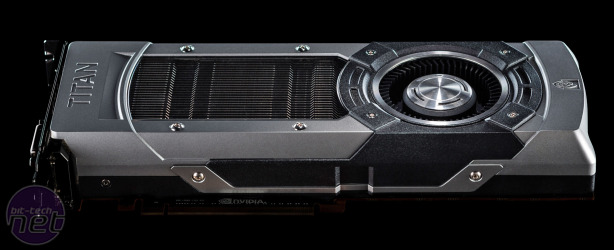
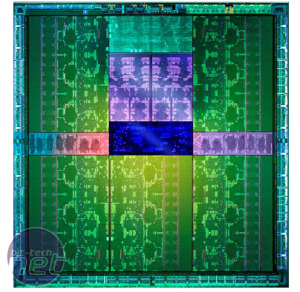
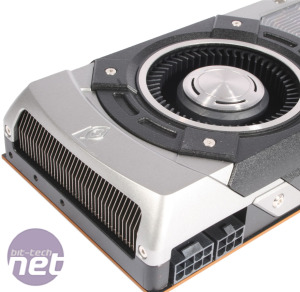







Want to comment? Please log in.